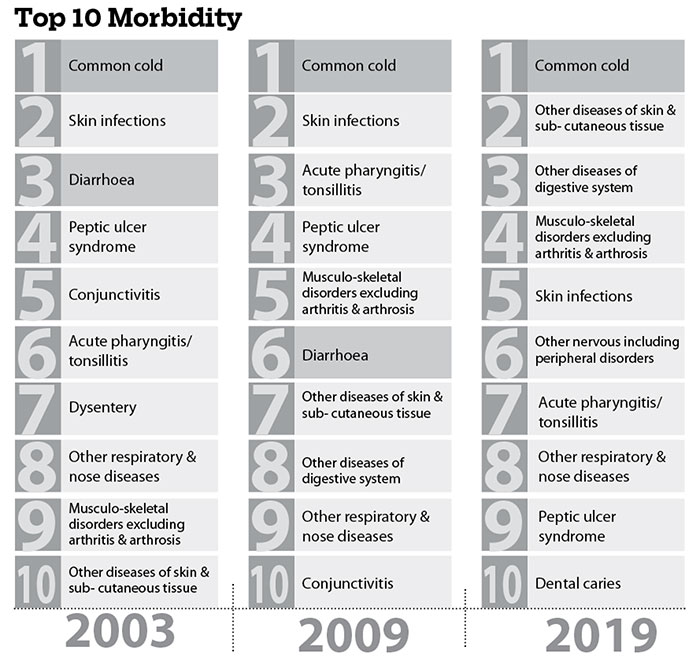Awareness, behavioural change and vaccination behind the success
Younten Tshedup
Cases of common cold and diarrhoea, the leading causes of morbidity among Bhutanese, has decreased so much that diarrhoea is now out of the top 10 list of morbidity in the country.
As per the routine health records, between January and August this year, the country recorded 111,812 common cold cases. Although the numbers are high, it is a decrease of about 70,000 cases as compared to the same period in 2019. There were 180,948 flu cases reported last year.

According to the health ministry’s annual health bulletin 2020, last year common cold accounted for 19 percent of the diseases in the country.
Similarly, the number of diarrhoeal cases in the country have also declined by almost 13,000 since last year. As of August, this year, there were 19,244 diarrhoeal cases as compared with 31,803 during the same period in 2019.
Health officials attribute the declining number of flu and diarrhoea cases to a combination of several public health prevention programmes and awareness among the public.
The decline this year, although no studies were done, is also linked to the increased frequency of handwashing in the light of the Covid-19 pandemic.
Health Minister Dechen Wangmo on several occasions has said that the ministry’s decade-long effort to promote handwashing among the public was finally being realised due to the pandemic. “As we frequently wash our hands, our hands have become fairer than our faces.”
Besides preventing the spread of Covid-19, handwashing is a proven public health measure to avert diseases like flu, diarrhoea and other communicable diseases.
Programme analyst with the Department of Public Health, Chakchu Tshering, said that intensive awareness on public health measures, access to clean and safe drinking water, having proper toilets in every household and increased handwashing practise, among others have resulted in the flu and diarrhoea cases to drop over the years.
He said that the decreasing flu cases could also be because of the introduction of flu vaccines among the high-risk groups since last year. “The flu vaccine has proven effective and the ministry is providing the vaccine for the general public starting this year. This should further help reduce the number of cases.”
According to the annual health bulletin, the proportion of the population with access to safe drinking water has increased from 45 percent in the 1990s to over 98 percent in 2017.
Chakchu Tshering said that besides causing high morbidity rates, the number of deaths as a result of common cold and diarrhoea were also very high in the past. He said that although mortality (deaths) rates from the two diseases are low, it incurs huge costs on the government to treat those that get infected.
“It still is a concern as fever resulting from common cold could turn fatal especially in children if not treated on time,” he said. “Diarrhoea is also a serious illness as it drains all the essential minerals from the body. Cases like typhoid can be fatal if not treated on time especially among children.”
The programme analyst said that what the country was witnessing today was the labour and efforts put in decades ago in formulating the programmes. “We cannot expect immediate impacts of our health programmes as it takes years to show results. What we do now, the results would come only after 10-15 years.”
The control of diarrhoeal diseases (CDD) programme started in early 1980s followed by the acute respiratory tract infection control (ARI) programme. However, Chakchu Tshering said that activities were already ongoing as a part of general health service since the start of modern medicine in the country.
He said that the need to come up with dedicated programmes was felt because of the growing number of cases including deaths then.
“We have come a long way. Common cold and diarrhoea remains on the top-10 list of morbidity in the country but efforts are in place to bring them down.”
As per the annual health bulletin, since 2003 flu and diarrhoea dominated the top-10 list of morbidity in the country. Following gradual decline over the years, diarrhoea and dysentery cases were no longer among the top-ten morbidity by 2019.


